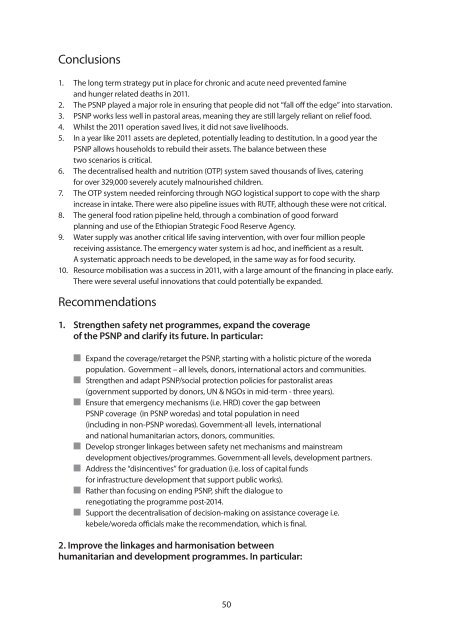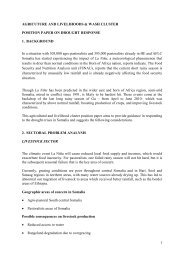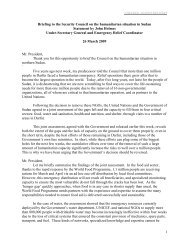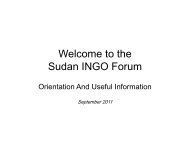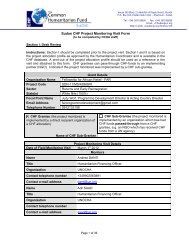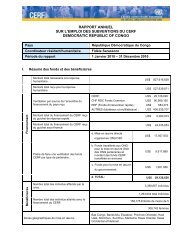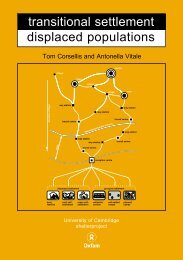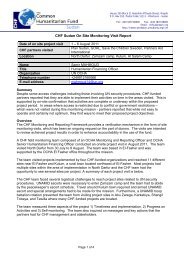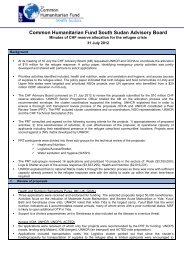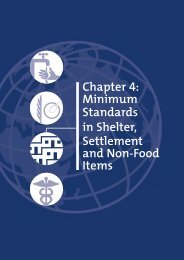Ethiopia - OCHANet
Ethiopia - OCHANet
Ethiopia - OCHANet
You also want an ePaper? Increase the reach of your titles
YUMPU automatically turns print PDFs into web optimized ePapers that Google loves.
Conclusions<br />
1. The long term strategy put in place for chronic and acute need prevented famine<br />
and hunger related deaths in 2011.<br />
2. The PSNP played a major role in ensuring that people did not “fall off the edge” into starvation.<br />
3. PSNP works less well in pastoral areas, meaning they are still largely reliant on relief food.<br />
4. Whilst the 2011 operation saved lives, it did not save livelihoods.<br />
5. In a year like 2011 assets are depleted, potentially leading to destitution. In a good year the<br />
PSNP allows households to rebuild their assets. The balance between these<br />
two scenarios is critical.<br />
6. The decentralised health and nutrition (OTP) system saved thousands of lives, catering<br />
for over 329,000 severely acutely malnourished children.<br />
7. The OTP system needed reinforcing through NGO logistical support to cope with the sharp<br />
increase in intake. There were also pipeline issues with RUTF, although these were not critical.<br />
8. The general food ration pipeline held, through a combination of good forward<br />
planning and use of the <strong>Ethiopia</strong>n Strategic Food Reserve Agency.<br />
9. Water supply was another critical life saving intervention, with over four million people<br />
receiving assistance. The emergency water system is ad hoc, and inefficient as a result.<br />
A systematic approach needs to be developed, in the same way as for food security.<br />
10. Resource mobilisation was a success in 2011, with a large amount of the financing in place early.<br />
There were several useful innovations that could potentially be expanded.<br />
Recommendations<br />
1. Strengthen safety net programmes, expand the coverage<br />
of the PSNP and clarify its future. In particular:<br />
n Expand the coverage/retarget the PSNP, starting with a holistic picture of the woreda<br />
population. Government – all levels, donors, international actors and communities.<br />
n Strengthen and adapt PSNP/social protection policies for pastoralist areas<br />
(government supported by donors, UN & NGOs in mid-term - three years).<br />
n Ensure that emergency mechanisms (i.e. HRD) cover the gap between<br />
PSNP coverage (in PSNP woredas) and total population in need<br />
(including in non-PSNP woredas). Government-all levels, international<br />
and national humanitarian actors, donors, communities.<br />
n Develop stronger linkages between safety net mechanisms and mainstream<br />
development objectives/programmes. Government-all levels, development partners.<br />
n Address the “disincentives” for graduation (i.e. loss of capital funds<br />
for infrastructure development that support public works).<br />
n Rather than focusing on ending PSNP, shift the dialogue to<br />
renegotiating the programme post-2014.<br />
n Support the decentralisation of decision-making on assistance coverage i.e.<br />
kebele/woreda officials make the recommendation, which is final.<br />
2. Improve the linkages and harmonisation between<br />
humanitarian and development programmes. In particular:<br />
50


